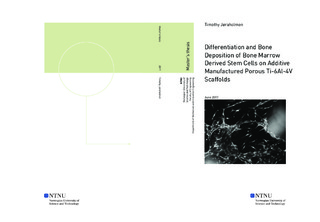| dc.description.abstract | The number of arthroplasty surgeries, or joint replacing surgeries, being performed each year is increasing worldwide. Younger patients are also being increasingly introduced to this kind of surgery, which means that the implants manufactured in the future need to last for an increased time span. Today, massive metal implants are commonly used. These are capable of causing an onset of stress shielding, lying at the basis of osteopenia: a painful condition where the bone in contact with the implant disappears, causing numerous costly and painful resurgeries.
By introducing additive manufacturing (AM) in the production of implants, porous structures can be manufactured thus lowering the stiffness characteristics of the implant. A factor that proves to reduce the onset of osteopenia.
Osteoblast precursors, i.e. bone marrow derived stromal cells (BMSCs), prove to be influenced by the surface roughness and porosity of the extracellular matrix. In fact, these cells can be influenced into osteoblast differentiation by the sole action of the surrounding implant structure. Having the knowledge on how surface topography induces cell fate is key to the fabrication of next generation implants.
In this Master's Thesis, the osteoconductive and the osteoinductive traits of additive manufactured Ti-6Al-4V porous structures was investigated. A porous scaffold design was developed and fabricated. The structures were then seeded with bone marrow derived mesenchymal stromal cells (BMSCs) to conduct a selection of in vitro studies. The seeded scaffolds were cultured in osteogenic medium (OM) and in non-osteogenic growth medium (GM) before the BMSC differentiation was assessed by a variety of experiments:
Adhesion of cells cultured in GM showed a widely spread cell morphology, when characterised by confocal microscopy. As expected, the amount of adhered cells seemed to increase over the course of 48 hours. Multiple alamarBlue stainings, showed a BMSC activity increment within the first five days of culturing in OM. This trend was also observed by BMSCs cultured in GM, as the activity level caught up to the OM cultured cells by day 9. Alkaline phosphatase (ALP) staining at day 10 showed an extensive ALP expression by OM cultured cells and partial staining of GM cultured cells, suggesting the onset of BMSC differentiation into osteoblasts. Experiments using real-time PCR analysis showed a slight upregulation of RUNX2 and osteocalcin after 21 day of culture, possibly suggesting an onset of differentiation. Alizarin red stainings, provided indications of mineralisation for BMSCs cultured in both mediums, although more mineralisation was found in OM cultured cells. Scaffolds are found to have good osteoconductive properties, but moderate ostoinductive tendencies.
This study sets the foundation for understanding surface topography effects on BMSC differentiation in 3D porous scaffolds and might lead to a new area to be explored in future implant design. | |

